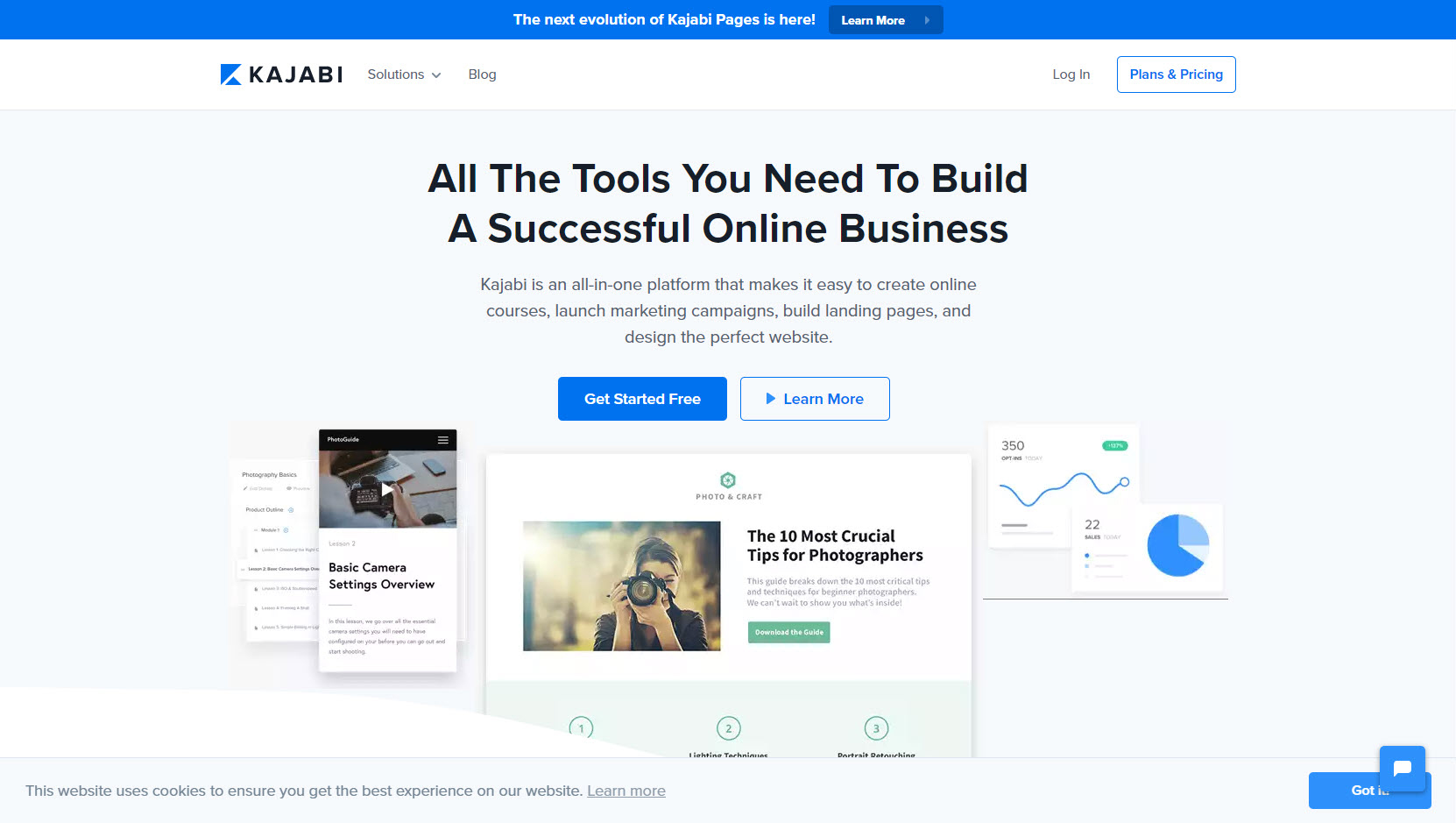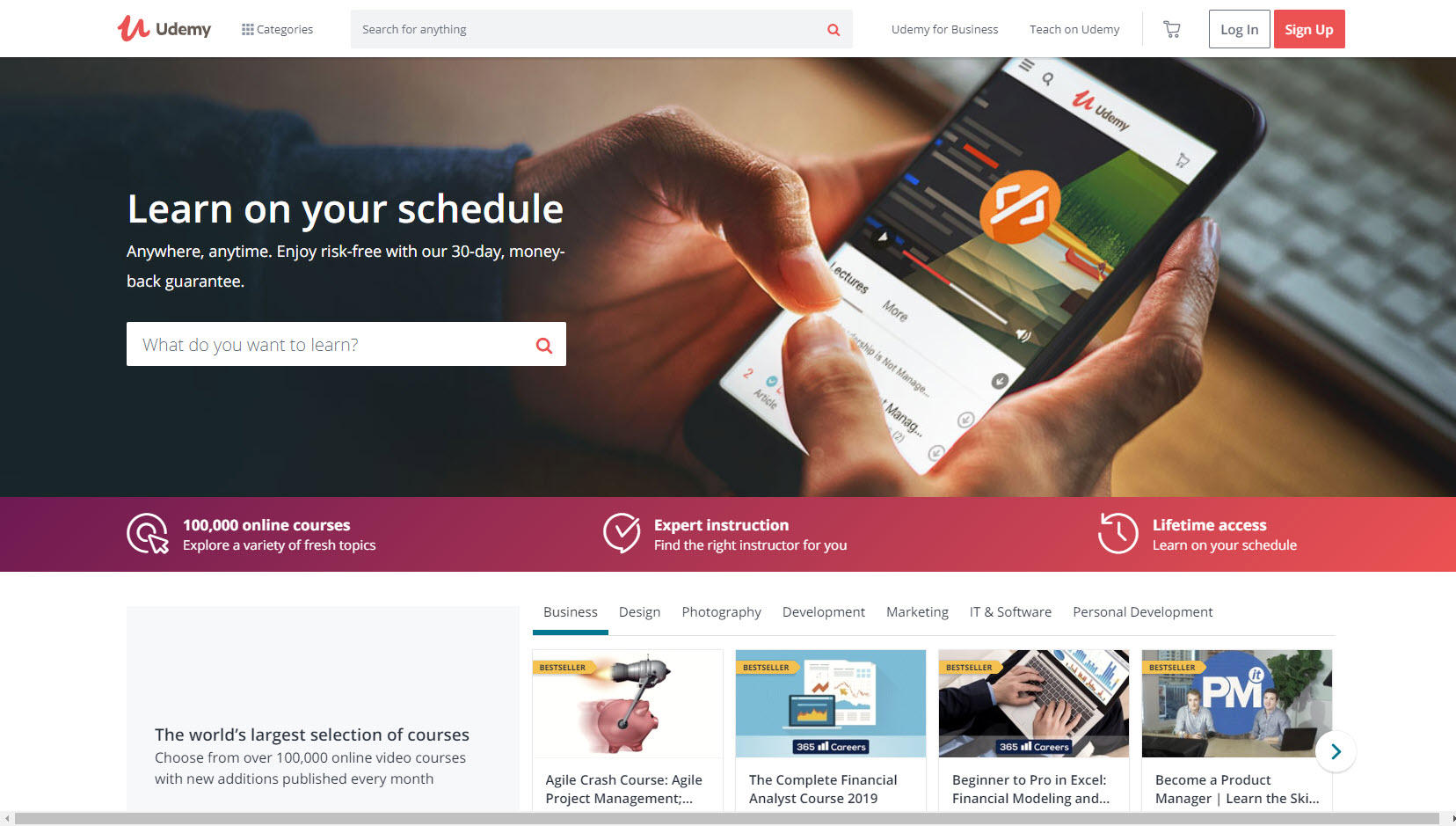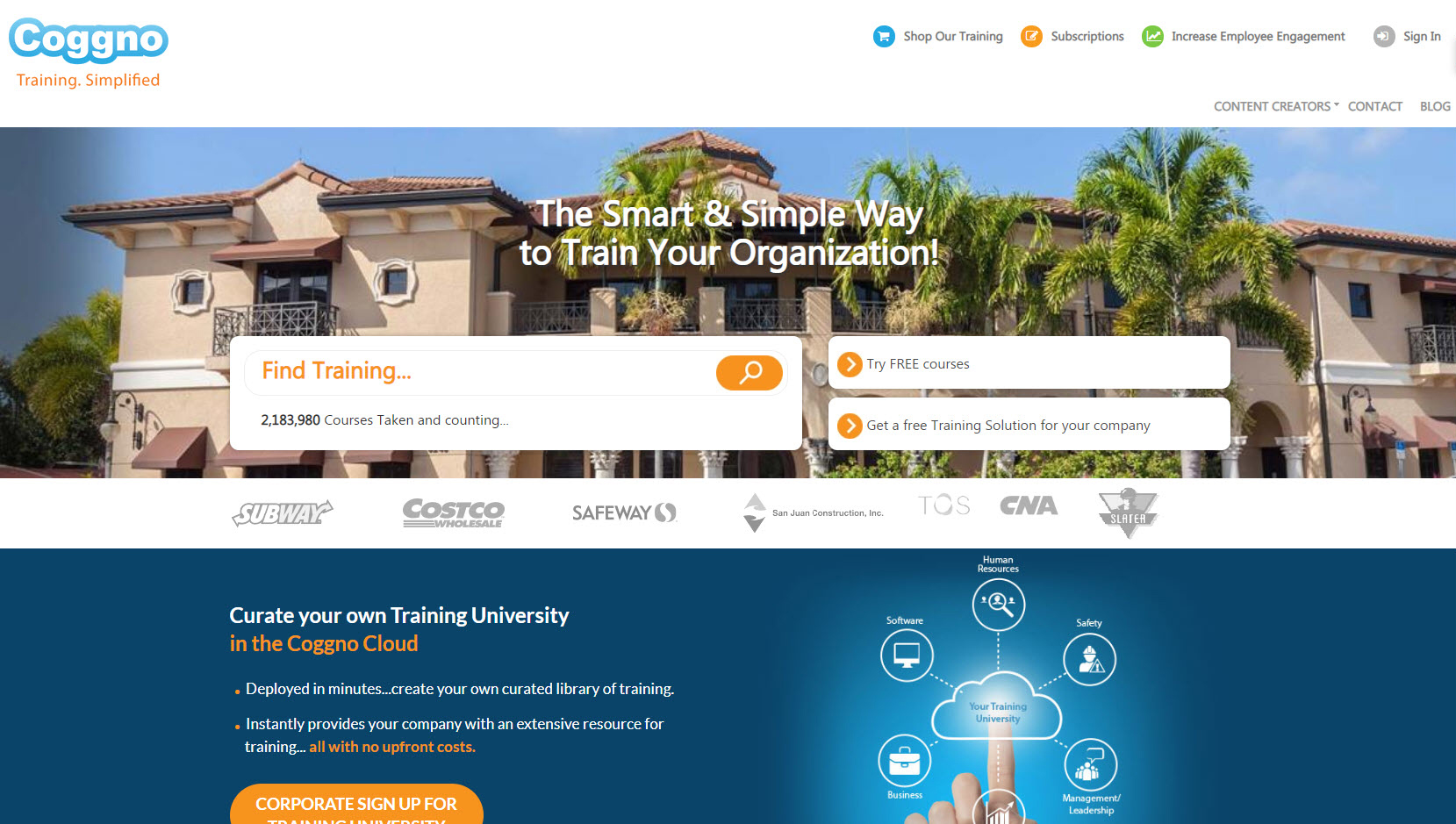The Must-Know Pros and Cons of Online Learning Platforms
It is not easy to choose an online learning platform because there are many learning management systems that have been around for more than twenty years. The importance is to comprehend their features and how they can help you achieve your goals.
First, you need to know what the online learning platforms are and the advantage and disadvantage of them.
What Are Online Learning Platforms?
Online learning platforms are types of learning management systems (LMS) that provide users with access to digital classes. These online courses are similar to offline classes in many ways. For example, a teacher provides knowledge and engaging educational experience through video, image, text, audio, and PDF files. Students use LMS software to take notes, perform exercises, and complete exams to verify knowledge.
The Range of Online Learning Platforms
Online learning platform solutions can be a complex market space to navigate as an online course instructor. They range from “marketplaces” where anyone can create and sell online courses of any quality to platform solutions that partner only with educational institutions as well as other LMS platforms that allow instructors to design a proprietary online course platform and market their online classes.
Self-Hosted Online Learning Platform
These are platforms that are built on your web hosting. You can create online courses on a WordPress website by using a membership site plugin or an online course plugin that is a simple way to have a self-hosted course site.
The pros of self-hosting your online courses
Student’s email addresses are yours
If you want to have full control and ownership over your student’s email addresses, you should self-host your online courses. This helps you continue and develop a closer relationship with your students. Their personal information is a crucial element to build trust and get repeat sales.
You have full control: branding, customization, integrations
You can customize the interface of your online school, change your logo, market your brand, integrate with other services, manage your own affiliates in your own ways because you are a boss on a self-hosted platform.
Financial management
You can charge as much as you want for your online courses because of your self-host. In addition, you can provide payment plans and even recurring paid subscriptions. You can get most revenue generated which depends on your hosting plan except for a small transaction fee or even have not to get paid ever again.
Joint venture partners
You can take advantage of joint venture partners to sell premium courses. This is one of the most effective ways because they are individuals who are looking for high-quality courses to promote to their audiences. JV partners do not agree to boost a course hosted on a marketplace because their cut would be too small to make a promotion worthwhile.
The cons of self-hosting your online courses
Marketing is time-consuming
Self-hosting means that you run your own business by yourself. It is dependent on figuring out how to develop marketing strategies and sales channels as well as attract and convert leads into real customers. It is hard and time-consuming to market online courses. However, if you apply the right strategies with perseverance, you will not have problems thriving on your own.
Expensive maintenance costs
Hosting on marketplaces is complimentary, they only get paid on selling one of your courses. On the other hand, all self-hosting platforms charge recurring hosting fees. At the first stage, these fees are small but as soon as your online school is developed, they get more expensive. For example, email marketing automation tools may be very expensive once you start approaching thousands of students.
More work
You must be in charge of managing all the parts of your online school when having more control. It is easy to start but once you have plenty of students as well as some online courses, you will face unexpected problems with managing everything.
Lack of credibility
Everybody is confused that whether or not to trust your online school because they do not know who you are or you are a celebrity, influencer, or represent a well-known brand. Furthermore, there is a bit of filtering on marketplaces their review and rating system is very hard to hack which makes easy to spot bad instructors. For self-host, it is not difficult to fake student reviews and testimonial that does not make them credible.
Top 5 self-hosted online learning platforms
#1: Teachable

Teachable helps course creators develop and nurture an online audience by offering different options to customize the interface and feel of courses. No need to tinker with the code even if you are not tech-savvy, you can use templates available files from Dropbox, Google Drive, and OneDrive, among other content formats instead of the Power Editor.
It also allows instructors to freely make decisions on course prices, provide courses on their own. They can offer courses themselves or in bundles, or pick among a one-time fee, or a payment plan, or a subscription.
Furthermore, Teachable’s native email marketing tool is used to filtered and sent a message to students when they enroll in a course, redeem a coupon, or complete a course. And keep in touch with former students? Add them on your list with Teachable’s integrations (for a special offer maybe).
#2: Podia

If you wish to build an online store, Podia should be your best help. It is easy to create online courses, digital downloads, and also membership sites.
Podia provides storefronts that all have the same template. This makes users not to feel overwhelming. In each store’s landing page, it includes an overview, a content section, a ‘What’s included’ section, FAQs, and creator bios. All of the presenting courses, memberships, digital downloads are stored on a separate landing page.
Moving on to creating courses, Podia allows you to publish the online courses immediately or you can pre-launch them to collect emails, perhaps. In case you have additional resources to supplement your courses – sheets, eBooks, videos, audio, text, checklists, etc. – that you want to sell as digital downloads, you can bundle and sell them together.
Moreover, you can create your own private loyalty/membership site, share updates with your community, notify them about new products and business growth, with different plans, perks or content for each type of the members.
#3: Thinkific

For any starters, Thinkific is a trusty guide because of its simple and easy-to-use templates. It is said to be one of the easiest website builders to use.
Every course on Thinkific is created with two parts: course material and landing page. To begin with, pick ones you are needed from the following templates: mini-course, flagship course, digital download, membership bundle, or webinar replay. The difference that makes Thinkific stand-out among other course builders is that once you start with a blank slate, Thinkific templates will provide helpful tips and cues in order to build a valuable course immediately.
Besides, the templates are pre-populated with examples, downloads, research results, and also instructor messages apart from several video lessons. You may add or remove the content which you want to see, or you might follow the template as is; it’s up to you.
#4: Kajabi

Helping users to create their own automation is one of Kaiabi’s key features. It offers a remarkable number of if-then scenarios for users to choose from. Whenever a student completes an assignment, fills in forms, cancels a subscription, or has been inactive for a while, you can send him an email, register him for a meeting or unsubscribe him from your email list. Kaiabi also has a native email provider which helps you to track the quantity and frequency of your emails opened.
Additionally, Kaiabi is well-known among busy course creators for its power of marketing. Pipelines, its marketing blueprints, gives significant help to connect landing pages to checkout pages (for course launches, special offers and more) with just a few clicks.
Moreover, you can choose what to do with the email that you collect. Add them to an email sequence, remind them of a special offer, or maybe a thank-you note for purchasing. Kaiabi has all kinds of pages you need, all you have to do is select a Pipeline, add content, and that is how your marketing machine all set.
#5: Ruzuku

It is found in several surveys that many people recommend Ruzuku for its native video streaming option, which fills the gap of interaction with students, unlike most of the course creation platforms.
Ruzuku’s integrated video conferencing service or external services like Ustream or Livestream allows notifying students about an upcoming webinar. When it’s time, visit the Events page to start the call. You can convert presentations to PDFs and add them to the call. Students can view your presentation on their screens, along with living chat screens on one side during the call. This helps you to interact more with students. When your webinar is finished, you will find that a record of the call is available and ready to share. Remember that live chat content is no longer available after the call ends.
Online Learning Market
This is a large e-commerce site that sells many courses like an online “Walmart” for courses. If you only want to put your course out there and get paid at the end of every month, it is the best choice for you.
The pros of selling on marketplaces
Marketing done for you
The biggest advantage of hosting courses on a marketplace is reaching a lot of your sales that are directly driven by the marketing efforts of that marketplace. They perform marketing strategies well and spend hundreds of thousands of dollars in search engine optimization every month.
Huge student base
An established online course marketplace can attract hundreds of thousands as well as millions of potential buyers into a single pool. If you take part in this marketplace, your courses have many chances to be shown to thousands of highly targeted buyers who are looking for the topic of your courses based on their course recommendation engine.
Large support communities
There are much free help and access to large instructor online communities to make sure that their instructors are happy so they stick around. This is where everyone is encouraged to motivate and help one another succeed.
Credibility
A marketplace has been around for years and has developed a strong brand and credibility that is one of the key factors to build trust in potential buyers. Because they prefer to purchase from a known brand rather than an unknown independent brand.
The cons of selling on marketplaces
No access to student’s email addresses
This is the greatest weakness of hosting courses in a marketplace. As we know, the biggest asset of online course creators is their students. However, in a marketplace, students belong to the marketplace instead of you. This makes it difficult to scale your business outside the marketplace because you cannot build and develop relationships with your students in your own ways.
Lose control
You not only cannot access to your student’s contact information but also lose control of time and money. For example, how often you can communicate with your students and what you can promote or not when you message them that depends on the marketplace. Besides, the marketplace also decides how much you can charge for your courses, and how long you have to wait to get paid.
If you do not comply with the marketplace rules and status, you can get kicked out and lose access to all your students at once. It means all the revenue you derive depending on the marketplace.
No free marketing
The marketplace invests in promoting your courses at a high cost. In fact, the marketplace plays a role as an affiliate and they can take 50% or more of commission every sale they generate and the instructor only gets to keep 25% of each sale. Perhaps that’s the reason why an instructor makes less than $3 per sale on a course priced at $200.
Your brand gets diluted
The marketplace just has an interest in promoting its brand, not yours. You cannot customize the interface of your course pages and more. Therefore, you must remember that you are working for them and not your ways if you participate in a marketplace.
Top 5 online learning marketplaces
#1. Udemy

Udemy is a purely online course marketplace model that has evolved over the last few years. It is developed and well known to Teachinguide users and readers over the past few years. If instructors use this platform, they can set the price for their courses and get a share of sales revenue which depends on the source of the sale.
Udemy is well-known as the best place for new instructors to test and practice their online teaching skills. It provides the biggest marketing power in all the compared online learning platforms that helps instructors earn a passive and much larger income teaching online.
#2: Skillshare

Skillshare is the online course platform that is similar to Udemy. The key difference is that Skillshare is subscription-based and provides students access to a “library” of courses. Instructors get paid based on minutes viewed not a fixed course price.
Instructors can publish online “classes” instead of online “courses” on Skillshare that means shorter content. Therefore, it is useful for instructors who are just getting started teaching online.
Skillshare has fewer courses and students than Udemy. However, it is not really a matter of concern if the quality is higher and more visibility for instructors. It gears toward “creative” teachers and students, and thus learning projects can be posted to the website for each course.
#3: Skill Success

Skill Success has revenue share policies that are similar to the Udemy platform. It differs from Udemy in several ways such as a much smaller scale and more. This online learning platform offers students a subscription model but not much information on course creation or what is required of instructors. Users only sign up to become an instructor and start creating courses like using Udemy.
#4: Coggno

Coggno is an online training marketplace and learning management system which entirely focused on business customers. It provides a service to connect content developers, HR organizations, and employees who need training. Its goal is to simplify corporate training and certification anywhere in the world.
Unlike most Udemy, you can create courses or upload your existing course content as well as SCORM files. Besides, you can also offer courses privately or distribute them through the Coggno online course marketplace.
#5: SkillWise

Skillwise is a subsidiary of Stack Commerce which created a very large global distribution network for digital content, including online courses. Skillwise focuses on IT, development, business, design and photography classes. If you do not teach in one of these areas, this platform will not suitable for you.
Skillwise provides extensive marketing and content creation support because it allows you to access Stack Commerce’s network, which includes over 750 publisher’s stores including AOL and the Huffington Post.
Instructors can get 50 % of sales from courses sold on 6 websites that Stack Commerce owns (such as Stackskills) and 30 % on partner sites. It will determine the final price for your courses based on your suggested price. Skillwise helps instructors sell more courses by combining many courses into a learning path for consumption.
Conclusion
After understanding features of each online learning platform, you should actually use them by creating a mock course and testing them on a few students to find out the suitable platform meeting the need of your online school. In the selection process, if you are in two minds about choices, leave your question in the comments below. We are always happy to help you.
You Might Also Like: Udemy vs. Teachable: Which One Is Right for You?









